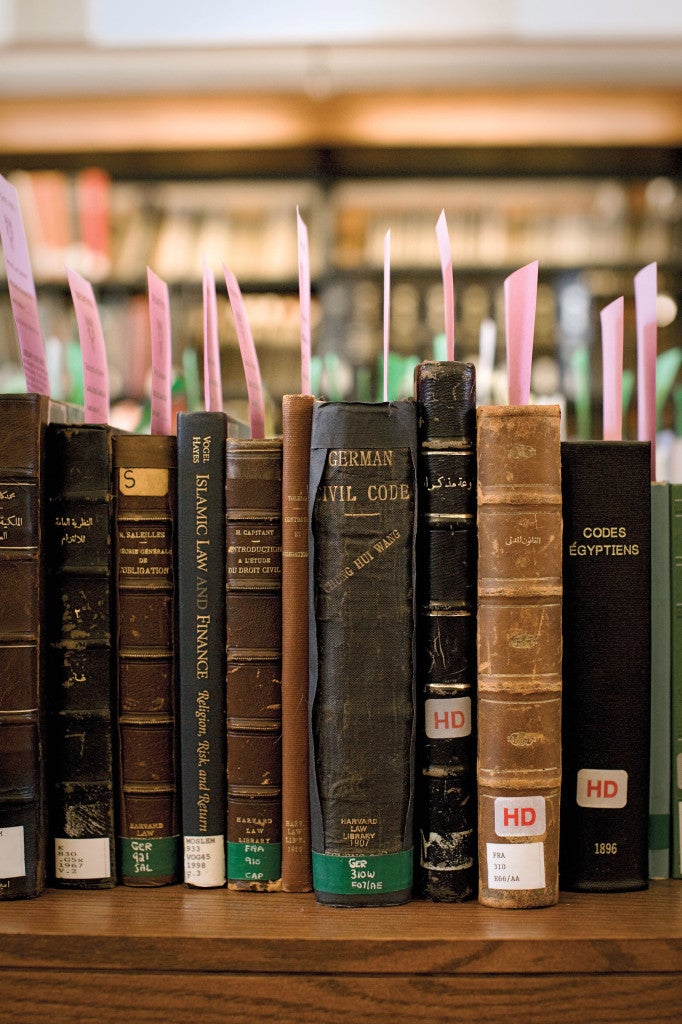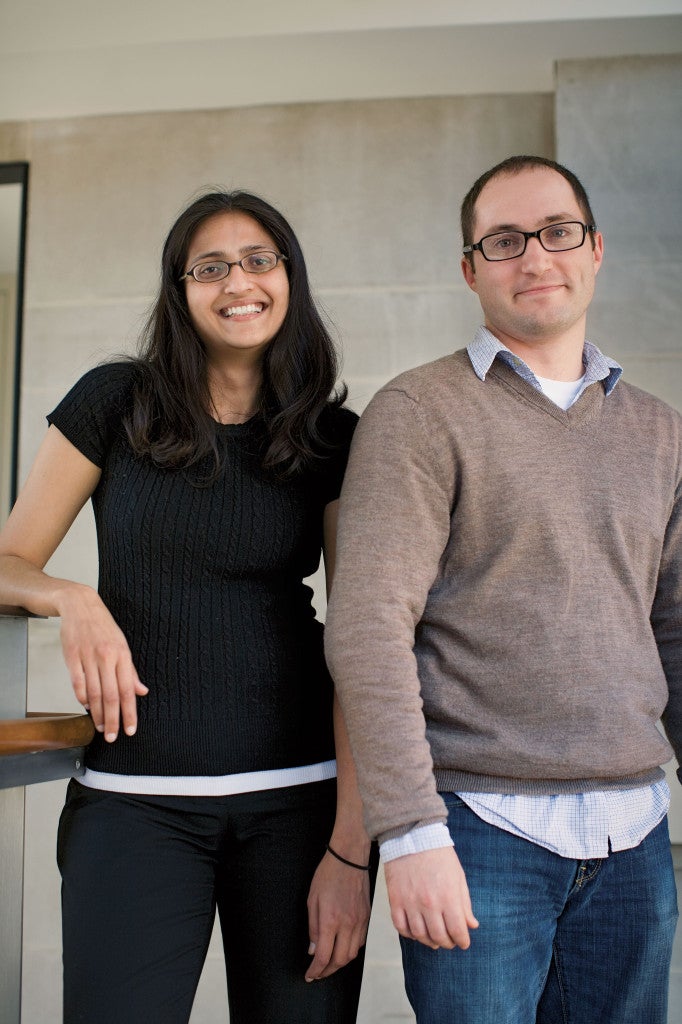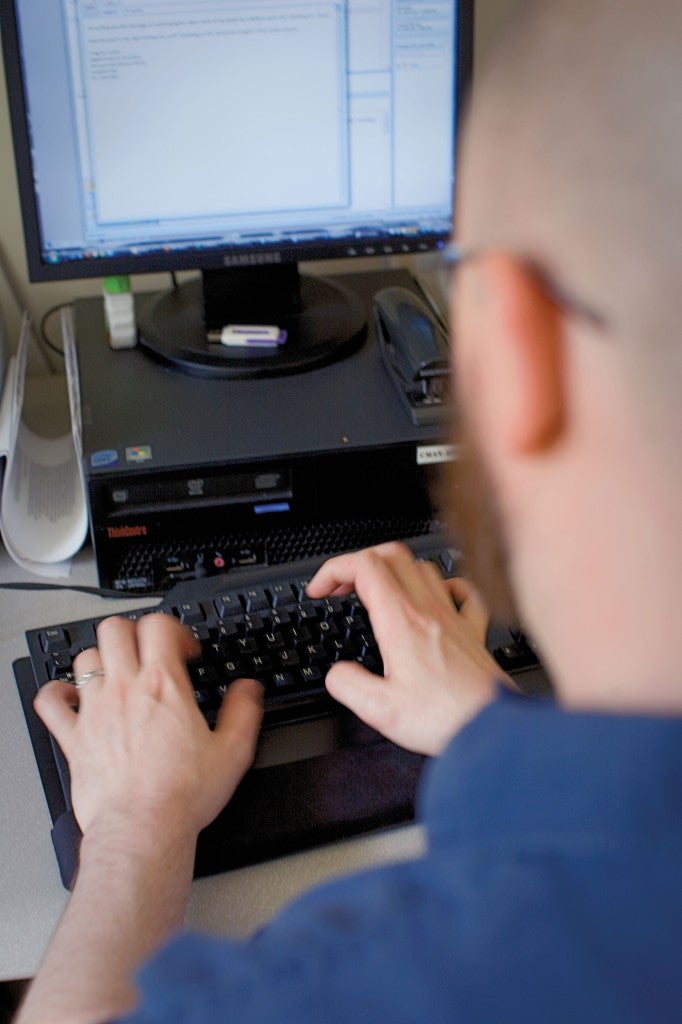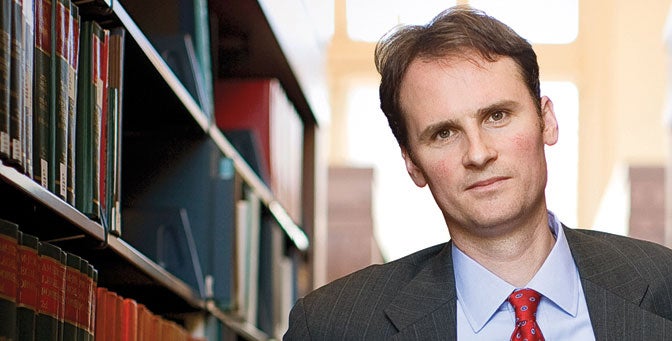“We have to define ‘library’ differently than in the past. We have to define it before it is decided for us.”
—Professor John Palfrey ’01, vice dean for library and information resources
A catalog entry sparks the imagination: On March 6, 1935, Gutzon Borglum, the sculptor who sited Washington, Lincoln, Roosevelt and Jefferson on Mount Rushmore, was in Washington, D.C., casting wet plaster over the lifeless face of former Supreme Court Justice Oliver Wendell Holmes Jr. LL.B. 1866. The object he was creating would eventually measure 26 x 17.5 x 18 centimeters, be purchased from Borglum’s widow for $1,077, and be held forevermore at Harvard. Today, Holmes’ death mask, along with his desk, straight razor and annotated copy of his seminal work, “The Common Law,” is now visible the world over, online, courtesy of the Harvard Law School library.

Holmes’ final likeness is but one of hundreds of thousands of objects—together with 2 million volumes—in the law school’s collection, now in the earliest stages of digital preservation and cataloging. And digitization, itself a remarkable feat of stewardship, is only one piece of a larger effort to launch the library into the future.
The 21st-century legal academy emphasizes interdisciplinary study, international law and empirical legal research. When the law school reformed its curriculum in 2007 and 2008 to accommodate these new emphases, it was clear that the library needed to keep pace. The question was, how? As dean, Elena Kagan ’86 commissioned an external review. The resulting report became the primary blueprint for re-envisioning and reorganizing the library, a process led by John G. Palfrey ’01.
Palfrey, who for six years helped to run the law school’s Berkman Center for Internet & Society, was appointed vice dean for library and information resources in 2008. Palfrey is not a librarian. He is, however, a law professor and cyberspace visionary, who has published extensively on the Internet’s relationship to intellectual property and on the ways digital technologies are changing society. His task in his current position is to meld the old, the new and the emerging digital-era library. To do so, Palfrey says he has built on the legacy of his predecessor, HLS librarian Terry Martin. He also draws on the expertise of his librarian staff.
Palfrey kicked off the library’s reorganization by laying out his broad vision and appointing a nine-member, professionally diverse steering committee to design its implementation. A year later, on April 30, 2009, the committee issued its report. The result: a new structure that opens the law school’s extraordinary collections to the world; leverages support for, and access to, law-school-generated scholarship; strategically develops the collections; streamlines and modernizes traditional library functions; and—critical in this volatile time for libraries—prioritizes innovation.
Palfrey says part of what drives the changes is “a realization that we have to define ‘library’ differently than in the past. The reason for my urgency is that we have to define it before it is decided for us,” he adds, noting efforts by businesses like Google to take on library-like functions in ways that are motivated by for-profit, rather than scholarly, concerns.
The law library’s reorganization is one piece of a larger project to modernize Harvard’s entire $165 million, 1,200-person library system. The university recruited Palfrey to contribute to the provost’s library task force, and since November he has been a member of a team looking into how to implement the task force’s recommendations. Harvard Divinity School Professor David Lamberth, who chairs that effort, says Palfrey’s empirically based observations pushed them “to envision not only the digital future that is changing the landscape for information services and libraries, but the reality of the digital present for so many of our patrons.” And in many ways, he says, the law school library’s reorganization has provided a testing ground for the wider university efforts.
From resource to academic partner
A striking accomplishment of the reorganization is a library that proactively assists faculty and students in the production and dissemination of new knowledge. “Libraries are now less about having a set of materials that you store and more about knowledge management,” says Palfrey. “How do you help create materials in partnership with faculty and help curate those materials?”

One answer: Hire statisticians. The library has taken the unusual step of hiring two full-time employees to crunch the numbers for the law school’s empirical legal researchers. For the uninitiated: Empirical legal research is an emerging field that crosses all legal disciplines. It might look, for example, at whether it is possible to predict how the makeup of the Supreme Court affects decisions in rape cases; the effects of various regulatory structures on corporate behavior; ethnic voting patterns with implications for redistricting; or the efficacy of programs for reducing gun violence. Assistant Professor James Greiner’s empirical research focuses on the effect of assigning counsel to indigent civil litigants. He says, “[Palfrey’s] team looks at information, and understanding information, as their general purpose, and that means that they’re willing to get information from alternative sources, and they’re willing to hire staff that wouldn’t be considered traditional for libraries to hire.”Travis Coan, the statistician assigned exclusively to faculty, fields questions on issues ranging from how best to merge data files to programming statistical models. He sees demand for his services steadily growing—consistent with the larger trend, visible particularly over the last decade, of an explosion in empirical legal scholarship. “I think the law library and John Palfrey are trying to get in on the ground floor of that action,” says Coan.
Statistician Parina Patel works with students doing original research in their empirical law courses for eventual publication, and occasionally guest-teaches. One of her students, Jaime Eagan ’11, is researching the Americans with Disabilities Act. Patel helped Eagan glean from her data whether the extent of an advocate’s expertise in ADA litigation is related to the outcome of a case in a statistically significant way.
Besides providing muscular statistical support to researchers, the library has also boosted support for the production and dissemination of knowledge through the expansion of its “scholarly communications” and “open access” functions. “Scholarly communications” refers to the process of supporting faculty along the road to publication. “Open access” refers to the movement to free scholarly work from the restrictions of for-profit publishing, and make it widely available on the Web. The law school faculty adopted an open access policy in 2008, and one benefit has been its impact on the bottom line.
Palfrey explains: “When Laurence Tribe writes an article for a law review, he’s not trying to make any money off of it. He is seeking to improve the understanding of a legal doctrine or a legal theory. And yet on the other side of that, the publishing apparatus works at cross-purposes. [It] charges us money for our own work to reacquire back into libraries, and likewise, doesn’t make it freely available to people who might in fact use it.” On a practical level, open access works like this: A faculty member publishes her work in a peer-reviewed journal, but retains the copyright and deposits an author’s final version (post-peer-reviewed, but pre-copyedited and pre-formatted) in the repository known as DASH (Digital Access to Scholarship at Harvard), where anyone can access it on the Web.
Veteran library staffer Michelle Pearse handles open access and scholarly communications for the library; the point of her job is to get content into DASH. She says, “Before [the library’s reorganization], 20 percent of my time was spent on open access; now, 80 percent of my time is.” With the law school now transitioning to open access, the number of law articles in DASH is fairly low, but Pearse is dedicated to changing that by conducting outreach to faculty members (part of her “scholarly communications” function) and also by handling the logistics necessary to bring works published before May 2008 into the repository.
Ramped up for the digital age

While deploying new resources for research and teaching, the library is also tackling what Palfrey calls the “digital-plus” era head-on. “We’re the largest academic law library in the world,” says Kim Dulin, associate director for collection development and digitization. “We should be putting it out there and making it more open.” Her unit boasts the new, in-house Harvard Library Laboratory, responsible for digitizing collections and for developing new ways for the library to serve its patrons through the Internet.
Jeff Goldenson, the laboratory’s designer and multimedia communications specialist, is experimenting with a Web application he developed called Stack View, which would allow the virtual browsing of library shelves. The Harvard Library Laboratory is also striving to make the library’s holdings more visible on Google and is developing a project called Shelf Life, which, as described by Dulin, “has the goal of exposing the richness of Harvard library holdings on the Web in a new and different way.” An early demo version is expected this summer.
Basically, the laboratory is aiming to build a virtual library architecture as easy to navigate as the physical library. To see the value of this work, take a look at the library’s website where portions of the historical and special collections are posted (see http://tinyurl.com/specialcollections). These collections are massive: more than 200,000 printed materials in the library’s rare books and early manuscripts collection; more than 250 collections within the modern manuscripts collection; and one of the world’s largest collections of law-related art and visual materials. Cataloging these items for the Web is a monumental task, but the results are breathtaking: See, for example, “Statham’s Abridgment,” a collection of 15th-century English Year Book cases from the time of Henry VI; or Bracton’s law treatise from the early to mid-1200s; or the Ruhleben civilian internment camp papers from World War I; or the ongoing project to digitize the 1 million pages of documents related to the Nuremberg Trials—all online.
The brave new world of collection development
Once upon a time, the library collected everything, in every language, related to law. No more. “There’s so much more published every year, the cost of what is published is increasing, and the formats have multiplied,” says Palfrey. “So the expectations for some people are that we’ll have a book or journal in hard copy; on the other hand, some people want a digital version to be able to search or do something with. It’s too expensive to do both.” These realities led the library to develop its first-ever collection development policy.
HLS, of course, is not the only law school facing these pressures, so collections have become a natural area for law schools to work together. Palfrey calls this cooperative effort “radical collaboration,” both because it has never been done before and to make a point: “Even the wealthiest, strongest libraries cannot go it alone in the digital-plus era we’re getting into,” he says.
The library is also more strategic about collecting the laws of other nations. “We have laws here that people don’t have in their own countries, so they have to come here to use them,” says Dulin. The library has discontinued collecting the laws of countries like Switzerland, which are easily accessible from other sources, and instead focuses on putting online the laws of countries with unstable regimes or with too few resources to preserve the laws they have developed.
With the goal of making as much available online as copyright restrictions allow, the library has hired Nika Engberg ’10, the first Harvard Library Laboratory Fellow. Engberg researches copyright and intellectual property issues and their impact on digitization and online availability.
Ready for anything
“This is a moment when libraries are rethinking everything,” Palfrey says. No one knows yet how to organize the library’s website for optimal searching and browsing, what the law school’s future library needs will be, or what social media the library might invent or adopt to connect with patrons. “How do we do the traditional work that has made this a great library historically while also transitioning to an era where libraries have very new jobs to do?” he asks.
To meet this challenge, Palfrey and his staff have embedded innovation into the library’s organizational structure. Beyond the obvious example of the laboratory’s research and development work, they have borrowed Google’s 80/20 work principle, allowing staff members to spend 80 percent of their time at their assigned jobs and 20 percent in other areas of the library. Palfrey believes this will improve internal communications, productivity, innovation and service. At this stage of the reorganization, more than half of the staff is availing itself of 80/20 opportunities. Palfrey believes more staff will get involved over time.
Another example of planned innovation: Collection development, previously a discrete job, is now considered a librarywide responsibility. News of library resource needs can now reach the collection coordinator faster, and from more constituencies.
Finally, the entire hierarchy of the library, which has a staff of about 90, is now flatter and more porous, allowing freer communications throughout the organization. Teams are regularly convened and dispersed to execute special projects. As much as possible, the reorganized library stands ready to tackle anything.
If these changes feel dizzying, it’s reassuring to hear Palfrey say, “We haven’t stopped ordering books. We haven’t stopped ordering serials. We do acquire more electronic resources, but we still need to catalog them.” In other words, Palfrey and his staff are re-envisioning the law library at the same time that they are improving the core services it has always provided. They are, as Palfrey puts it, merging “the classical and the jazz.” The point of this merger: to better support the faculty and students who are heralding in the future of law.
